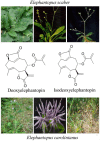Deoxyelephantopin and Isodeoxyelephantopin as Potential Anticancer Agents with Effects on Multiple Signaling Pathways
- PMID: 28635648
- PMCID: PMC6152668
- DOI: 10.3390/molecules22061013
Deoxyelephantopin and Isodeoxyelephantopin as Potential Anticancer Agents with Effects on Multiple Signaling Pathways
Abstract
Cancer is the 2nd leading cause of death worldwide. The development of drugs to target only one specific signaling pathway has limited therapeutic success. Developing chemotherapeutics to target multiple signaling pathways has emerged as a new prototype for cancer treatment. Deoxyelephantopin (DET) and isodeoxyelephantopin (IDET) are sesquiterpene lactone components of "Elephantopus scaber and Elephantopus carolinianus", traditional Chinese medicinal herbs that have long been used as folk medicines to treat liver diseases, diabetes, diuresis, bronchitis, fever, diarrhea, dysentery, cancer, and inflammation. Recently, the anticancer activity of DET and IDET has been widely investigated. Here, our aim is to review the current status of DET and IDET, and discuss their anticancer activity with specific emphasis on molecular targets and mechanisms used by these compounds to trigger apoptosis pathways which may help to further design and conduct research to develop them as lead therapeutic drugs for cancer treatments. The literature has shown that DET and IDET induce apoptosis through multiple signaling pathways which are deregulated in cancer cells and suggested that by targeting multiple pathways simultaneously, these compounds could selectively kill cancer cells. This review suggests that DET and IDET hold promising anticancer activity but additional studies and clinical trials are needed to validate and understand their therapeutic effect to develop them into potent therapeutics for the treatment of cancer.
Keywords: Elephantopus carolinianus; Elephantopus scaber; apoptosis; cancer; deoxyelephantopin; inflammation; isodeoxyelephantopin.
Conflict of interest statement
The authors declare that there is no conflict of interest regarding the publication of this paper.
Figures




Similar articles
-
Deoxyelephantopin and Its Isomer Isodeoxyelephantopin: Anti-Cancer Natural Products with Multiple Modes of Action.Molecules. 2022 Mar 24;27(7):2086. doi: 10.3390/molecules27072086. Molecules. 2022. PMID: 35408483 Free PMC article. Review.
-
Isodeoxyelephantopin, a Sesquiterpene Lactone Induces ROS Generation, Suppresses NF-κB Activation, Modulates LncRNA Expression and Exhibit Activities Against Breast Cancer.Sci Rep. 2019 Nov 29;9(1):17980. doi: 10.1038/s41598-019-52971-3. Sci Rep. 2019. PMID: 31784542 Free PMC article.
-
Sesquiterpene Lactone Deoxyelephantopin Isolated from Elephantopus scaber and Its Derivative DETD-35 Suppress BRAFV600E Mutant Melanoma Lung Metastasis in Mice.Int J Mol Sci. 2021 Mar 22;22(6):3226. doi: 10.3390/ijms22063226. Int J Mol Sci. 2021. PMID: 33810045 Free PMC article.
-
Sesquiterpene lactones isolated from Elephantopus scaber L. inhibits human lymphocyte proliferation and the growth of tumour cell lines and induces apoptosis in vitro.J Biomed Biotechnol. 2012;2012:721285. doi: 10.1155/2012/721285. Epub 2012 Feb 1. J Biomed Biotechnol. 2012. PMID: 22500104 Free PMC article.
-
A review on pharmacology and toxicology of Elephantopus scaber Linn.Nat Prod Res. 2014;28(11):819-30. doi: 10.1080/14786419.2014.883394. Epub 2014 Feb 5. Nat Prod Res. 2014. PMID: 24499355 Review.
Cited by
-
Oxidative stress, free radicals and antioxidants: potential crosstalk in the pathophysiology of human diseases.Front Chem. 2023 May 10;11:1158198. doi: 10.3389/fchem.2023.1158198. eCollection 2023. Front Chem. 2023. PMID: 37234200 Free PMC article. Review.
-
Deoxyelephantopin Suppresses Pancreatic Cancer Progression In Vitro and In Vivo by Targeting linc00511/miR-370-5p/p21 Promoter Axis.J Oncol. 2022 Jun 25;2022:3855462. doi: 10.1155/2022/3855462. eCollection 2022. J Oncol. 2022. PMID: 35794978 Free PMC article.
-
Salvianolic acid B in cancer therapy: pharmacokinetic profile, anticancer mechanisms and translational potential.Med Oncol. 2025 Jul 18;42(8):347. doi: 10.1007/s12032-025-02892-1. Med Oncol. 2025. PMID: 40679646 Review.
-
Deoxyelephantopin induces apoptosis via oxidative stress and enhances gemcitabine sensitivity in vitro and in vivo through targeting the NF-κB signaling pathway in pancreatic cancer.Aging (Albany NY). 2020 Jun 11;12(11):11116-11138. doi: 10.18632/aging.103327. Epub 2020 Jun 11. Aging (Albany NY). 2020. PMID: 32526702 Free PMC article.
-
Deoxyelephantopin induces cell death in oral cancer cells via the downregulation of AKT1-mTOR-mediated mechanisms.J Oral Maxillofac Pathol. 2025 Apr-Jun;29(2):193-205. doi: 10.4103/jomfp.jomfp_41_25. Epub 2025 Jun 30. J Oral Maxillofac Pathol. 2025. PMID: 40703820 Free PMC article.
References
-
- Begnini K.R., Moura de Leon P.M., Thurow H., Schultze E., Campos V.F., Martins Rodrigues F., Borsuk S., Dellagostin O.A., Savegnago L., Roesch-Ely M., et al. Brazilian Red Propolis Induces Apoptosis-Like Cell Death and Decreases Migration Potential in Bladder Cancer Cells. Evid. Based Complement. Altern. Med. 2014;2014:639856. doi: 10.1155/2014/639856. - DOI - PMC - PubMed
Publication types
MeSH terms
Substances
LinkOut - more resources
Full Text Sources
Other Literature Sources

